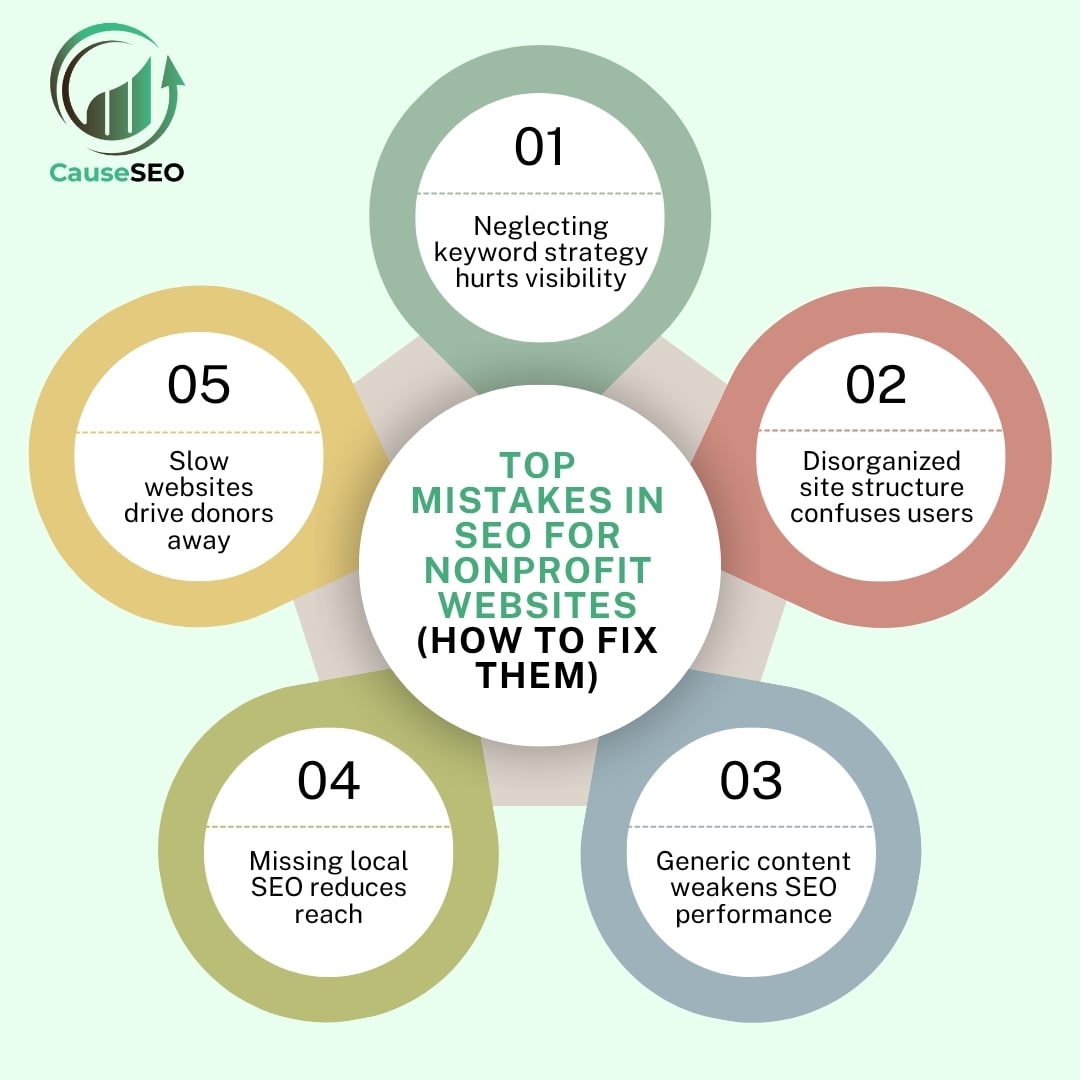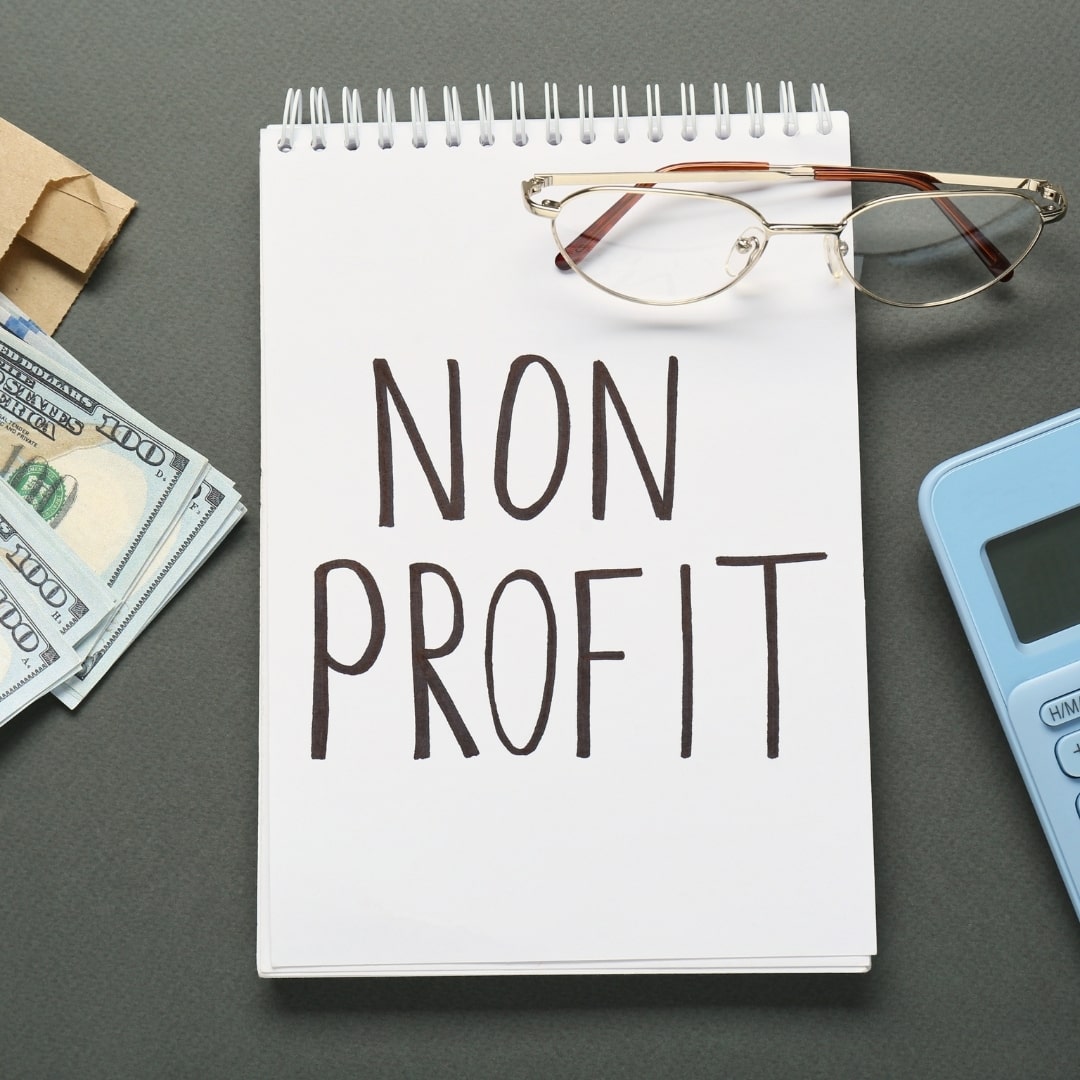Is your nonprofit website helping you reach the people who need you most, or is it getting lost in search results? SEO for nonprofit websites is essential for bringing in new donors, volunteers, and supporters. But many organizations unknowingly make mistakes that reduce their visibility online. Limited resources, outdated strategies, or missing technical steps can prevent your site from showing up when people search for causes like yours.
This guide walks through the most common SEO mistakes made by nonprofits and explains how to fix each one with simple, practical steps. From keyword problems to content gaps and website speed issues, every section is designed to help your organization improve its reach and grow its impact online.

Mistake #1 – Ignoring Keyword Strategy
The Problem
One of the biggest issues with SEO for nonprofit organizations and charities is that they often don’t focus on the right keywords. Some skip keyword research entirely. Others rely too heavily on vague phrases like “making a difference” or “helping the community,” which aren’t things people usually type into Google.
The Fix
Start by using free tools like Google Keyword Planner or Ubersuggest. These help you find search terms that real people are using. Don’t just target broad terms—go specific.
For example, instead of “support our nonprofit,” try “donate to animal shelter in Winnipeg” or “volunteer at women’s shelter in Toronto.” These long-tail keywords are more targeted and have a higher chance of bringing in supporters.
Make sure each page on your site has a unique focus keyword. If you’re offering different programs, each one should have its own page and target its own keyword phrase.
Mistake #2 – Poor Site Structure and Navigation
The Problem
A confusing website layout makes it hard for people to find what they’re looking for—and search engines struggle too. Important pages like donation forms or service areas are sometimes buried deep in the site or not linked at all.
The Fix
Create a clear and simple menu structure. Your site navigation should flow like this: Home → About → Programs → Blog → Contact. Use consistent labels. Avoid too many dropdowns or hidden links.
Make sure key pages like “Donate,” “Volunteer,” and “Our Impact” are in your top navigation and footer. Add internal links between related content, and use breadcrumb navigation where possible. These small changes make it easier for both users and Google to understand your site.
Mistake #3 – Thin or Generic Content
The Problem
Too often, nonprofit sites use brief or copied content that doesn’t say much. Mission statements may sound noble but lack detail. Service pages might be just a paragraph or two, with no clear explanation of what you actually do.
The Fix
Your content should tell real stories. Who do you help? How do you help them? What change have you made?
Include detailed descriptions, statistics, testimonials, and even photos or quotes from volunteers. This adds authenticity and helps you stand out. Don’t forget to include location terms and specific services.
Structure your content with clear headings, FAQs, and bullet points when needed. This helps improve relevance and user engagement, which search engines notice.
Mistake #4 – Not Optimizing for Local SEO
The Problem
Many charities and nonprofits rely on local support—but don’t show up in local searches. Not claiming your Google Business Profile or failing to mention your location on key pages can be a big setback.
The Fix
Claim and fully complete your Google Business Profile. Add your correct address, phone number, hours, and website link. Choose the right categories, like “Charity Organization” or “Food Bank.”
Add city and neighborhood names naturally to your homepage, service pages, and blog posts. Mention local events, partner organizations, and press mentions. These all help Google connect you with nearby searchers looking for help—or looking to help.

Mistake #5 – Slow or Unsecure Website
The Problem
Nonprofit sites are often built on tight budgets, which can mean slow hosting or outdated infrastructure. If your site loads slowly or doesn’t have an SSL certificate, people may leave before they even read your message.
The Fix
Upgrade to reliable hosting that supports fast speeds. Compress your images and use web-optimized formats like WebP. Install an SSL certificate (your site should use https://) and enable caching through your CMS or hosting provider.
Use tools like Google PageSpeed Insights or GTmetrix to check your performance. Aim for a mobile score above 90, especially for important pages like “Donate.”
Mistake #6 – Ignoring Mobile Optimization
The Problem
Many users will visit your site from a phone, especially if they discover you on social media or Google. If your site isn’t mobile-friendly, it can hurt both your user experience and your SEO rankings.
The Fix
Use a responsive design that adjusts smoothly on all screen sizes. WordPress themes that are mobile-ready can be a great starting point.
Check how your site looks and functions on phones and tablets. Make sure donation buttons, sign-up forms, and menus are easy to tap and navigate. Mobile experience is a major SEO signal, especially for local results.
Mistake #7 – No Ongoing SEO Monitoring or Updates
The Problem
Many nonprofit websites go live and then stay untouched for months—or even years. Without updates or tracking, your SEO performance will fade.
The Fix
Set up Google Analytics and Google Search Console to track visitors and search performance. These tools are free and offer valuable insight.
Run a full SEO audit for charities every quarter. Look for broken links, outdated content, and technical issues. Refresh old blog posts with updated stats and internal links.
If you’re looking for SEO services and long-term support, working with a charity marketing agency or a search engine optimization consultant like CauseSEO can make a big difference.

FAQs About SEO Mistakes on Nonprofit Websites
What’s the biggest SEO mistake nonprofits make?
Not having a clear keyword and content strategy. Without it, your message gets lost online.
How can we improve SEO on a small budget?
Focus on quality content, claim your local profiles, and use free tools like Google Search Console and Ubersuggest.
Do nonprofits need a blog for SEO?
Yes. A blog helps target long-tail keywords and signals fresh, ongoing activity to search engines.
Can social media help our SEO?
Not directly, but shared links can increase visibility and attract backlinks—both of which help.
How long does it take to see SEO results?
Usually 3 to 6 months for measurable growth, depending on how competitive your space is and how consistent your efforts are.
Conclusion
Most SEO mistakes on nonprofit websites are fixable. Common issues include weak keyword targeting, poor site layout, slow loading times, lack of local signals, and no monitoring. Fixing just one of these areas can lead to better visibility, more donations, and stronger engagement.
As more people turn to Google to find causes to support, SEO is no longer optional—it’s a vital part of your outreach. If your nonprofit is looking for SEO services or guidance, Cause SEO is here to help.
Contact us today at CauseSEO to get a full SEO audit for charities and start improving your online impact.

